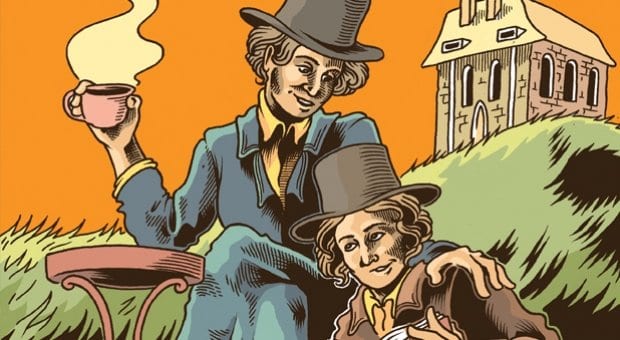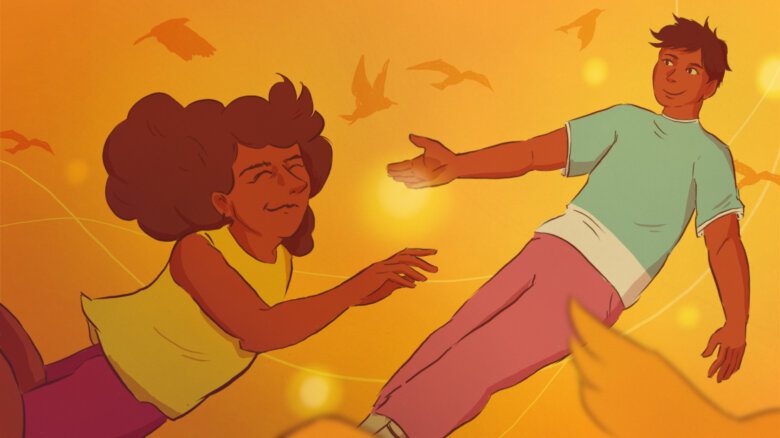My co-columnist and I have found kindred spirits in the Ladies of Llangollen. When we feel overwhelmed, we retreat to an imaginary place: Halifax. But, you say, surely Halifax is real. Yes, but that’s not our Halifax.
We often say that one day we’ll move to Halifax and open a tea shop in a secluded spot. Every morning Michael will dance a jig out onto the second-floor landing — his skirt flying as he kicks — tumble down the stairs, land on his rump with his skirt up over his head and call out, “Welcome, ladies!”
All the ladies will be drunk by mid-afternoon, by which time I will have made my way over from the nearby lighthouse, where I sleep, read and talk to my pet sheep. A bit odd, sure, but it’s our idea of paradise, sort of like the Ladies of Llangollen.
Eleanor Butler (1739–1829) and Sarah Ponsonby (1755–1831 or 1832) both came from aristocratic backgrounds and were born near one another in rural Ireland. Butler’s father was an earl and Ponsonby’s great-grandparents included an earl and a viscount. The two met in 1768 and, despite their age difference (Butler was 29 and Ponsonby was 13), became good friends.
Both women lived in difficult situations. Butler’s family wanted her to become a nun and Ponsonby’s family wanted her to marry a man. Or, by some accounts, Ponsonby was abused by her guardian, Sir William Fownes, who wanted to make her the next Lady Fownes. To avoid their families’ wishes, the two attempted to run off together to England with only a pistol and Ponsonby’s dog, Frisk. Their flight failed, but to avoid further scandal their families allowed the two women to move in together in about 1778.
They left Ireland and bought a cottage near Llangollen, in northeast Wales. Their hideaway, which they named Plas Newydd (Welsh for “New Place”), may not have been as comical as our “Halifax,” but it seems to have been their idea of heaven, and the pair was not without eccentricities. Two ladies living together and without men (in what would later be referred to as a “Boston marriage”) was itself very unusual, but they also enlarged their cottage, creating a sort of mock-Gothic look, and filled it with thousands of books and lots of oddities, including a letter from the King of France and a strand of hair from Mary Queen of Scots. They engraved their initials on glass and silverware. Their unusual lifestyle earned them the nickname the “Ladies of Llangollen,” or just The Ladies.
The two seemed to want only to live a quiet life: reading, writing, embroidering and strolling together through the village in “mannish” clothing. But their lifestyle and literary interests made celebrities of them. Many famous figures visited them, including Lord Byron, Sir Walter Scott, Edmund Burke and William Wordsworth, who wrote this about them: “Sisters in Love, a love allowed to climb,/Even on this earth, above the reach of Time!”
It’s unclear whether they were lesbians. They slept in the same bed and referred to one another as “my beloved” and “my better half,” but such intimacies were common between friends and relatives. When a 1790 newspaper article implied their relationship was sexual, it made them angry. Burke consoled them, writing “you suffer only by the baseness of the age you live in.” To others, it was clear that the two were a same-sex couple. Anne Lister, a contemporary famous for describing her lesbian experiences in her extensive diaries, wrote of the pair, “I cannot help thinking that surely it was not Platonic.”
Whether or not they were lesbians, it’s clear they were brave women who challenged conventions by living as they pleased. If I ever visit Wales, I’ll visit Plas Newydd, which is now a museum, and the graveyard at St Collen’s Church, where I hope Butler’s and Ponsonby’s gravestones still stand. I’d like to read the touching inscription that was written on Ponsonby’s: “She did not long survive her beloved companion, Lady Eleanor Butler, with whom she lived in this valley for more than half a century of uninterrupted friendship.”
(History Boys appears on Daily Xtra on the first and third Tuesday of every month. You can
also follow them on Facebook.)


 Why you can trust Xtra
Why you can trust Xtra


